--- title: "10 Best Free Whiteboard Layout Ideas in 2025: How to be More Productive?" author: Jackie Peng tags: Content slug: best-free-whiteboard-layout-ideas-organization description: “Explore innovative ways to organize your thoughts, plan projects, and tackle complex tasks. Discover how whiteboard layout ideas/setup can streamline your workflow and make information visually engaging, whether in the office, classroom or at home.” created: 2024-01-03 updated: 2025-01-03 layout: blog publish: true --- <img src="https://app.affine.pro/api/workspaces/qf73AF6vzWphbTJdN7KiX/blobs/a0TKbLywUMbtLI3fHHlEYtFK-TtEY-Z4jcB6EE_GI6Q=.webp" width="2400" height="1260" crossorigin="anonymous" /> Imagine being a project manager leading a complex, multi-departmental project involving various stages, key milestones, and stakeholder expectations. In this scenario, effectively conveying complex concepts, coordinating team members, and planning the project's path is crucial. A well-structured whiteboard layout plays a key role here. Using a [whiteboard](https://affine.pro/whiteboard), you can create areas to map different project stages, list key tasks and assign responsibilities, and have a dedicated space for creative brainstorming and problem-solving. This layout not only helps you and your team stay organized and focused but also provides a visual platform for tracking progress and facilitating communication among team members. Whether it's outlining a complex project plan or planning a team-building trip, a well-thought-out [whiteboard](https://affine.pro/whiteboard) layout simplifies the process and enhances team efficiency. ## So what is the Whiteboard Layout idea? 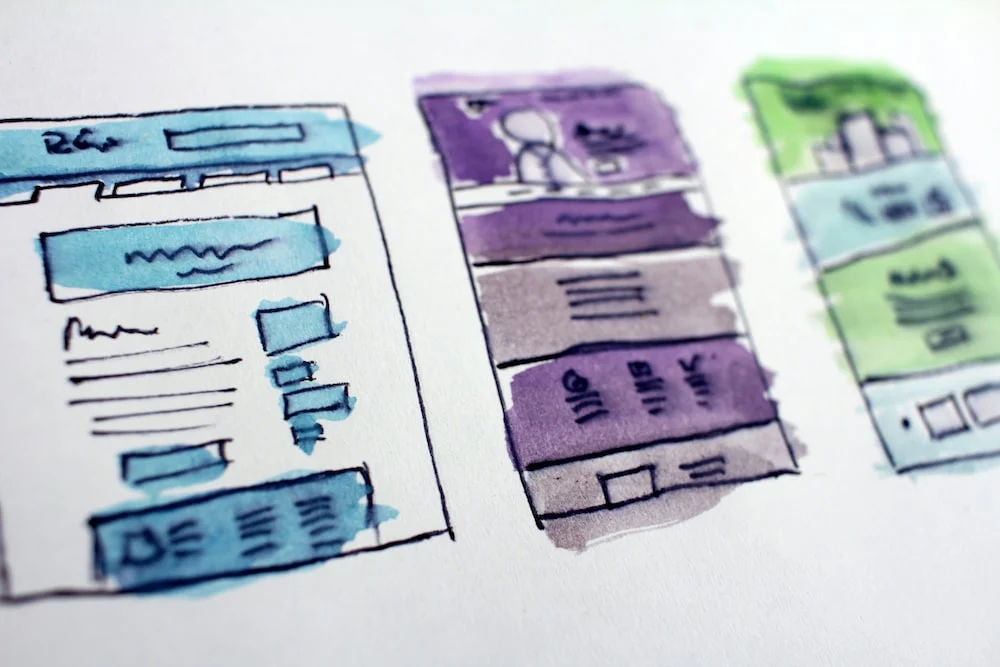 "Whiteboard Layout idea" refers to strategic methods of organizing a whiteboard to enhance productivity and efficiency in various settings, like offices, classrooms, or personal workspaces. These layouts are designed to optimize the use of space on a whiteboard for different purposes, such as project planning, brainstorming, or tracking tasks. Here’s an expansion on this concept: * Sectioned Areas: Divide the board into specific sections for distinct purposes, like a 'To-Do' list, a 'Brainstorming' area, and a 'Project Timeline'. * Color Coding: Use different colors to distinguish between tasks, priorities, or teams, making information visually distinguishable and easier to process. * Visual Aids: Incorporate diagrams, flowcharts, or graphs to represent complex information or data, aiding in clearer understanding. * Progress Trackers: Designate areas to track the progress of projects or goals, using tools like Gantt charts or Kanban boards. * Idea Generation Space: Reserve a freeform area for creative thinking and spontaneous ideas, encouraging innovation and team collaboration. Such layouts turn a simple whiteboard into a dynamic, multifunctional tool, greatly aiding in organizing thoughts, visualizing projects, and fostering a collaborative environment. 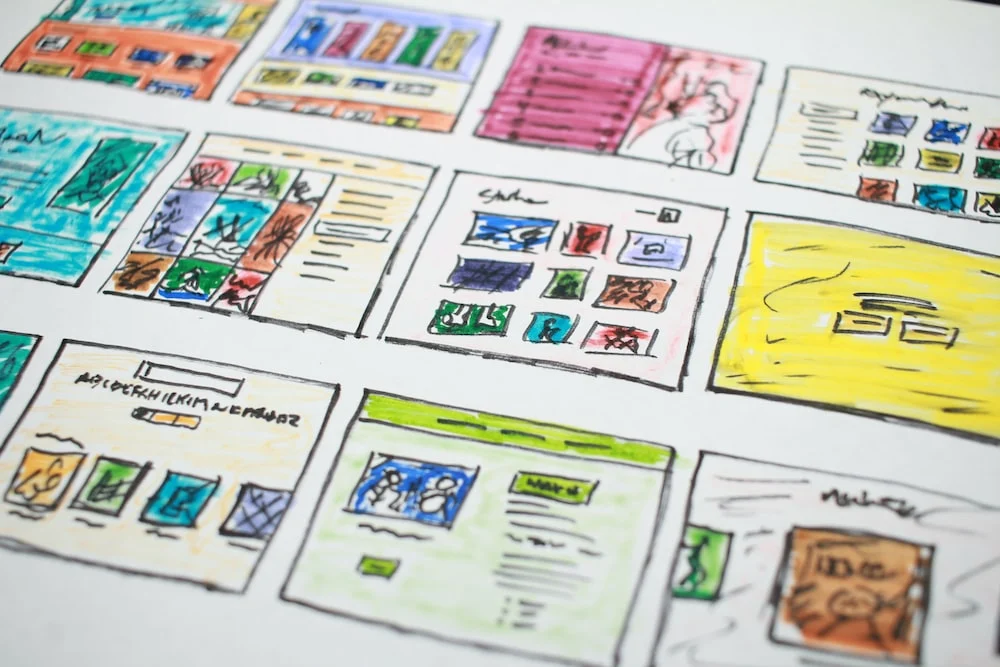 ## Why do the Whiteboard layout ideas matter that much? Organize whiteboard layout matters significantly because: * A good whiteboard setup idea enhances Organization: A well-structured layout helps in organizing thoughts, tasks, and projects in a coherent manner, making it easier to track and manage. * Boosts Productivity: By clearly visualizing tasks and deadlines, a whiteboard layout can streamline workflow, reduce time spent on planning, and increase overall productivity. * Facilitates Collaboration: In team settings, a well-planned whiteboard layout promotes effective communication, ensuring that all team members are on the same page and can contribute ideas easily. * Adapts to Different Needs: Different layouts can cater to various needs, whether it's for brainstorming, project management, or goal tracking, making it a versatile tool in both professional and personal settings. * Encourages Creativity: A designated space for brainstorming or freeform ideas can stimulate creative thinking and innovation. ## 10 Best Whiteboard layout ideas for work, home and daily life in [AFFiNE](https://affine.pro) ### 1) [Project planning](https://affine.pro) whiteboard layout idea 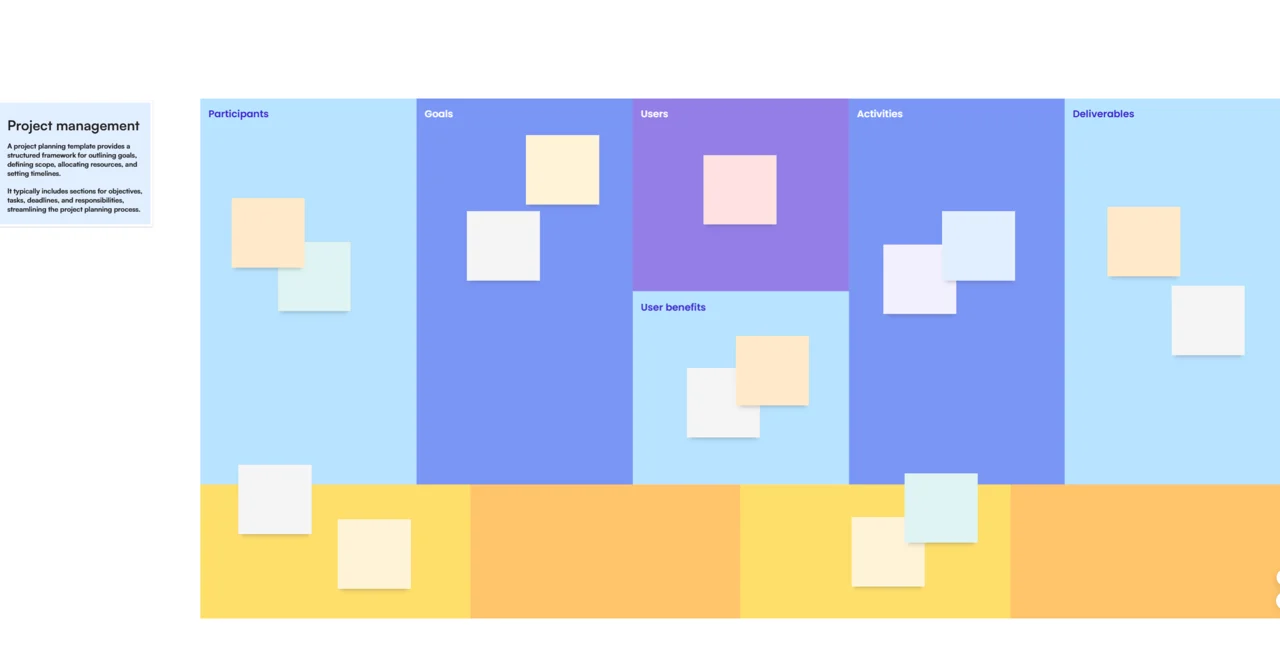 Imagine Jake, a project planner tasked with organizing a large-scale corporate event. His primary challenges include coordinating with numerous participants, setting clear objectives, understanding user needs, ensuring tangible benefits for users, planning various activities, and overseeing the creation of deliverables. The complexity and scale of the event mean Jake must be meticulous in his planning to avoid overlooking key details and to ensure every aspect aligns with the overall goal. To tackle this, Jake creates a project layout board. Each section - 'Participants', 'Goals', 'Users', 'User Benefits', 'Activities', and 'Deliverables' - is carefully laid out on a whiteboard. This [visual tool helps him map out every component of the event](https://affine.pro/blog/15-types-events-event-management-categories-examples). It becomes instrumental in tracking responsibilities, aligning team efforts with user expectations, and ensuring that every deliverable is accounted for and aligns with the set goals. This approach not only streamlines the planning process but also significantly reduces the risk of errors and miscommunication, ensuring a successful and well-organized event. Note that: * Clear Task Organization: Ensure that tasks are organized logically, possibly in a chronological order or based on project phases, so that team members can easily understand the project's structure and progression. * Dependencies and Relationships: Use arrows or lines to indicate task dependencies and relationships. This visual representation helps in understanding which tasks are linked and how they impact each other. * Key Milestones and Deadlines: Highlight critical milestones and deadlines prominently on the whiteboard. This ensures that all team members are aware of important dates and can plan their work accordingly. **Wanna get started with this layout right away,** [click here](https://app.affine.pro)**!** ### 2) [Storyboard Template](https://affine.pro/templates/category-storyboard-template) 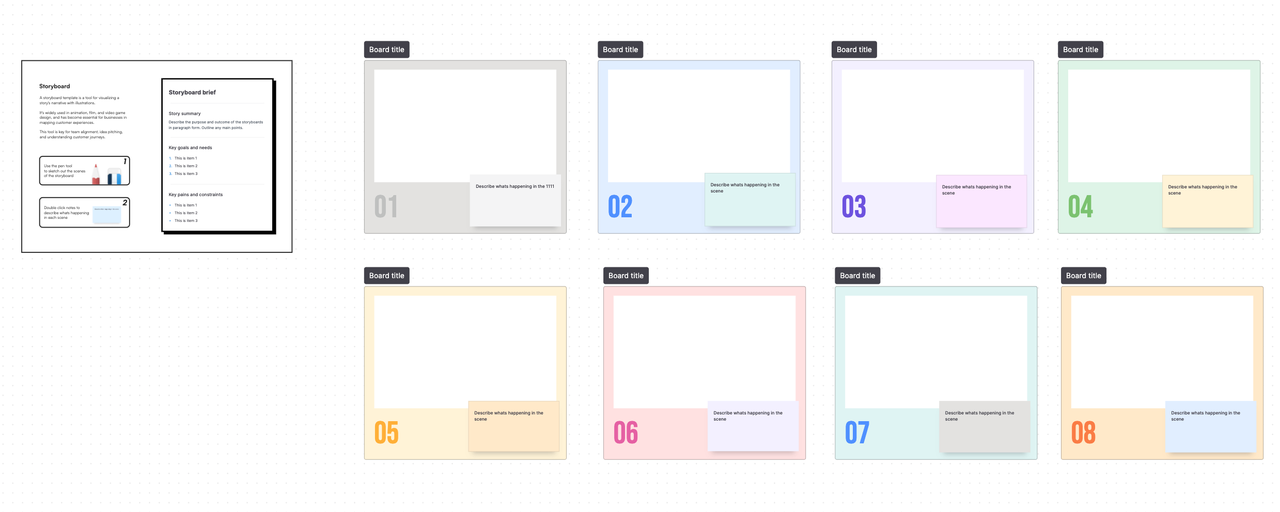 Consider a product designer at a tech company tasked with developing a new mobile app. This project requires a deep understanding of user experience, functionality, and design aesthetics. Storyboarding becomes a critical tool to visualize the user journey. Imagine the storyboard divided into panels representing different app screens, each illustrating user interactions, transitions, and key features. Additional sections outline user scenarios, potential challenges, and solutions. This detailed storyboard layout not only aids in visualizing the app's flow but also fosters collaboration with developers and stakeholders, ensuring a user-centric design that effectively meets the needs and expectations of the target audience. Note that: * Clarity: Ensure each element is clear enough for all viewers to easily understand. * Coloir Usage: Use colours judiciously to differentiate elements or highlight key points. Colors can signify emotions, priorities, or categories. * Visual Flow: The layout should guide the viewer's eye smoothly from one element to the next, creating a logical narrative sequence. * Space Utilization: Arrange each section thoughtfully to avoid overcrowding, leaving ample space for expansion or annotations. * Consistency: Maintain consistency in icons, fonts, and styles throughout the storyboard for easy recognition and comprehension. **Wanna get started with this layout right away,** [click here](https://app.affine.pro)**!** ### 3) [Swot map](https://affine.pro) whiteboard layout idea 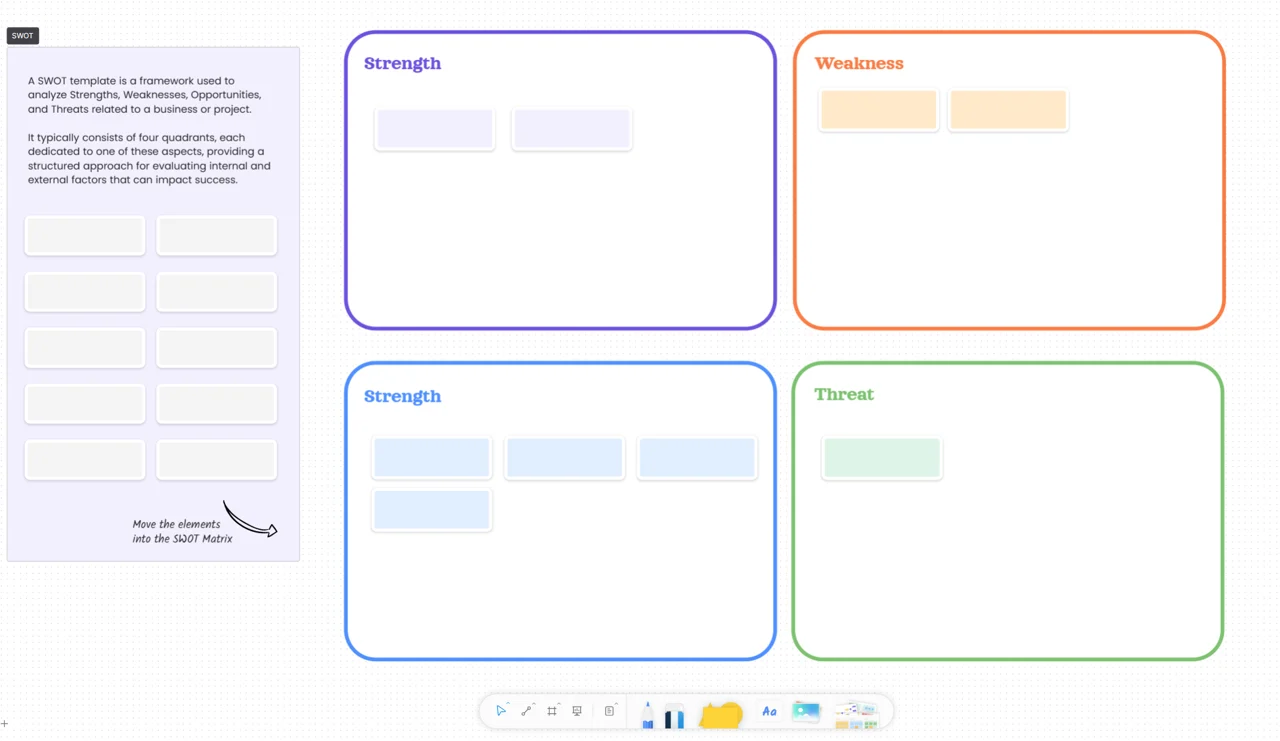 Imagine Laura, preparing for job interviews but uncertain about her strengths, weaknesses, opportunities, and threats (SWOT). She creates a SWOT analysis whiteboard to gain clarity. On the board, four quadrants represent each SWOT element. She lists her skills and experiences as strengths, identifies areas for improvement as weaknesses, notes potential career opportunities, and acknowledges external factors as threats. This visual SWOT analysis on her whiteboard helps Laura understand her professional profile, preparing her effectively for interviews by highlighting her assets and areas for growth, ultimately boosting her confidence and readiness for her job search journey. * Clear Quadrant Separation: Ensure that the whiteboard is divided into four distinct quadrants for Strengths, Weaknesses, Opportunities, and Threats. Clear separation allows for a focused analysis of each category. * Visual Representation: Use visual cues such as icons or color coding to make each point stand out within its respective quadrant. This aids in quickly identifying and understanding each SWOT element. * Actionable Insights: Encourage the team to discuss potential actions or strategies based on the SWOT analysis. Leave space for notes or ideas on how to leverage strengths, address weaknesses, seize opportunities, and mitigate threats. This makes the analysis actionable and practical. **Wanna get started with this layout right away,** [click here](https://app.affine.pro)**!** ### 4) [Smart Goal Template](https://affine.pro/templates/category-smart-goal-template)  Imagine Brian, a strategic executive, grappling with setting clear and actionable goals for his company's next big project. To bring structure to this process, he turns to a whiteboard organized by the SMART (Specific, Measurable, Achievable, Relevant, Time-bound) criteria. Brian's whiteboard is divided into sections, each dedicated to one of the SMART principles. In 'Specific', he defines the project's exact goals. 'Measurable' is used to establish criteria for tracking progress. 'Achievable' outlines the steps needed to reach these goals, ensuring they are realistic. 'Relevant' ensures the goals align with the company's broader objectives, and 'Time-bound' sets clear deadlines. This SMART board becomes a roadmap, guiding Brian's team to set and achieve well-defined, strategic objectives, ensuring the project's success and alignment with the company's overall vision. * Clear Goal Definition: Dedicate a section to define specific and concise goals, ensuring everyone understands what needs to be achieved. * Measurable Criteria: Include criteria and metrics for measuring progress and success. This allows for objective evaluation. * Timeline and Accountability: Set clear deadlines and assign responsibilities. This helps in keeping the project on track and ensures accountability among team members. Once Brian’s team hits key milestones outlined in the SMART template, like nailing a measurable target or meeting a time-bound deadline, celebrate their progress with **[Custom Medals](https://www.custommedals.co/us/)**. Engraved with the goal name, achievement date, or team logo, these medals turn the whiteboard’s strategic plans into tangible triumphs. <img src="https://app.affine.pro/api/workspaces/qf73AF6vzWphbTJdN7KiX/blobs/6vhF7ixUyK8y6SlGUhnrHO630xye-Qw-Q2mvWy4U25U=.webp" width="1536" height="1080" crossorigin="anonymous" /> They boost morale, honor accountability, and serve as lasting reminders of how structured goals fuel real success. Order now and get the medals as fast as possible. **Wanna get started with this layout right away,** [click here](https://app.affine.pro)**!** ### 5) [Calendar](https://affine.pro) for daily/monthly whiteboard ideas[](http://affine.pro) 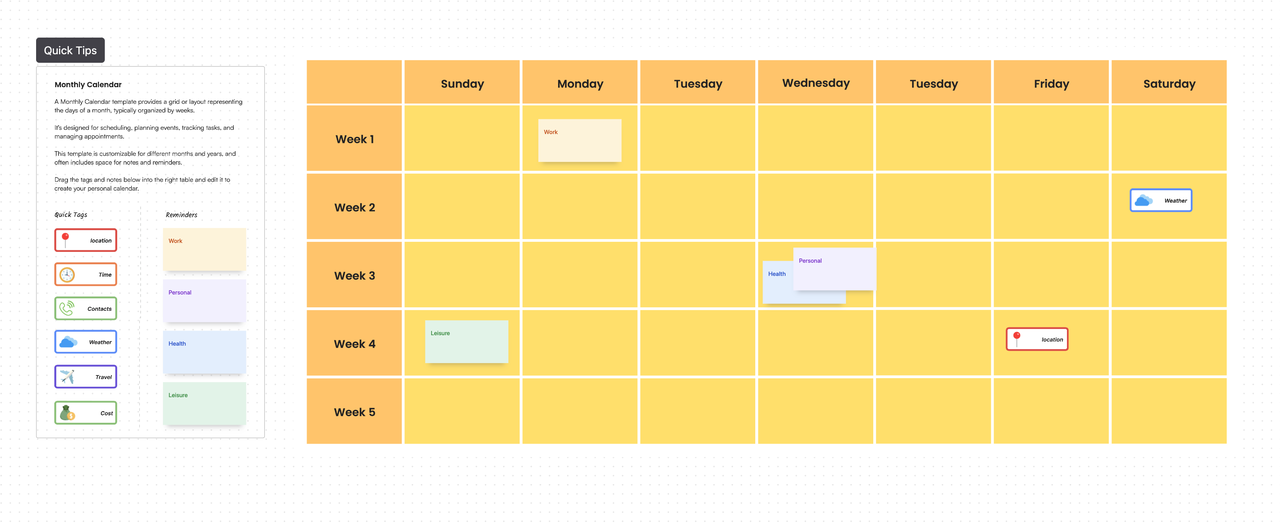 Anna, a dedicated working mother, faces the daily challenge of balancing a demanding job with her children's school activities and household responsibilities. Her routine includes a myriad of tasks ranging from professional meetings and deadlines to soccer practices, ballet recitals, and ensuring the home runs smoothly. To bring order to this chaos, Anna turns to a large whiteboard in her kitchen, transformed into a comprehensive digital monthly calendar. It's a kaleidoscope of colour-coded sections: yellow for work commitments, pink for each child's school and extracurricular activities, and green for family events and medical appointments. The lower section of the board is dedicated to meal planning and grocery lists, simplifying her weekly shopping chores. This whiteboard, more than just a planning tool, becomes the focal point of Anna's family life. It not only helps her keep track of diverse schedules but also ensures that she maintains a delicate balance between her professional responsibilities and her role as a mother, alleviating the stress of managing a busy household. Note that: * Clarity and Legibility: Ensure that the calendar is clear and easy to read from a distance. Use large, legible fonts and distinct colors for different types of events or tasks. * Flexibility for Changes: Incorporate elements like sticky notes or erasable markers, allowing for easy updates or adjustments as plans evolve throughout the month. * Space Allocation: Allocate sufficient space for each day, providing ample room for detailed notes or multiple entries, ensuring that the calendar doesn't become cluttered and remains organized. **Wanna get started with this layout right away,** [click here](https://app.affine.pro)**!** ### 6) [Concept Map](https://affine.pro) 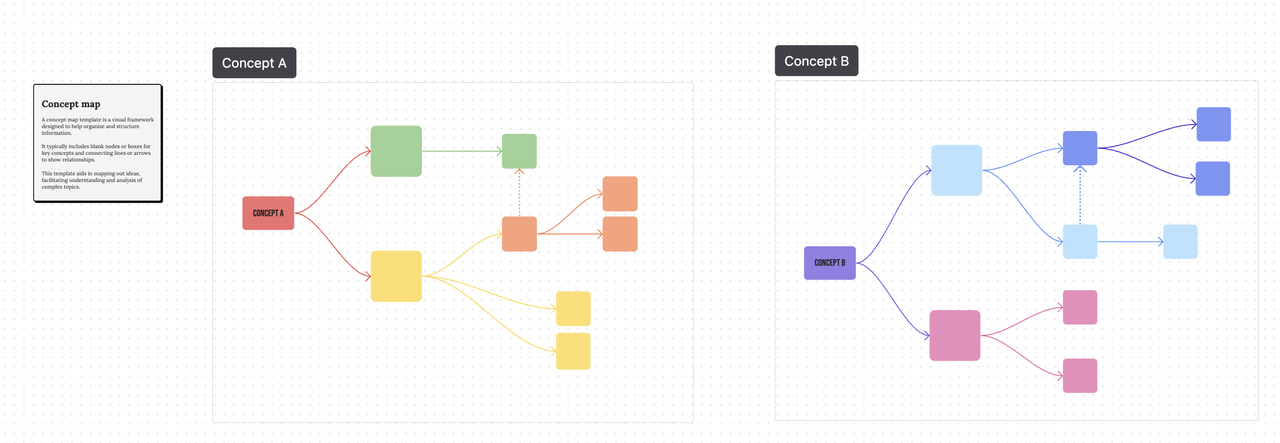 Imagine Mr. Thompson, a high school biology teacher, struggling to convey complex theories and concepts to his diverse group of students. To enhance understanding and engagement, he turns to a concept map. In his classroom, a digital whiteboard is transformed into this map. It's a web of interconnected ideas: central theories in the middle, branching out to sub-concepts and examples. Each branch is colour-coded by topic, with real-world examples and diagrams to illustrate abstract ideas. This visual and interactive approach transforms Mr. Thompson's teaching, making complex theories accessible and engaging. Students can see how different concepts connect, fostering a deeper understanding and making learning more dynamic and enjoyable. * Logical Flow and Organization: Arrange concepts in a way that clearly shows the relationships and hierarchy between them. This helps in understanding the overall structure and how individual ideas connect. * Use of Color and Symbols: Utilize different colors and symbols to distinguish between various concepts and links. This visual differentiation aids in quick recognition and understanding of the map. * Space for Expansion: Leave ample space around each concept to add details or additional sub-concepts. A concept map often evolves, so flexibility for growth is essential. **Wanna get started with this layout right away,** [click here](https://app.affine.pro)**!** ### 7) [Project-tracking Kanban](https://affine.pro) 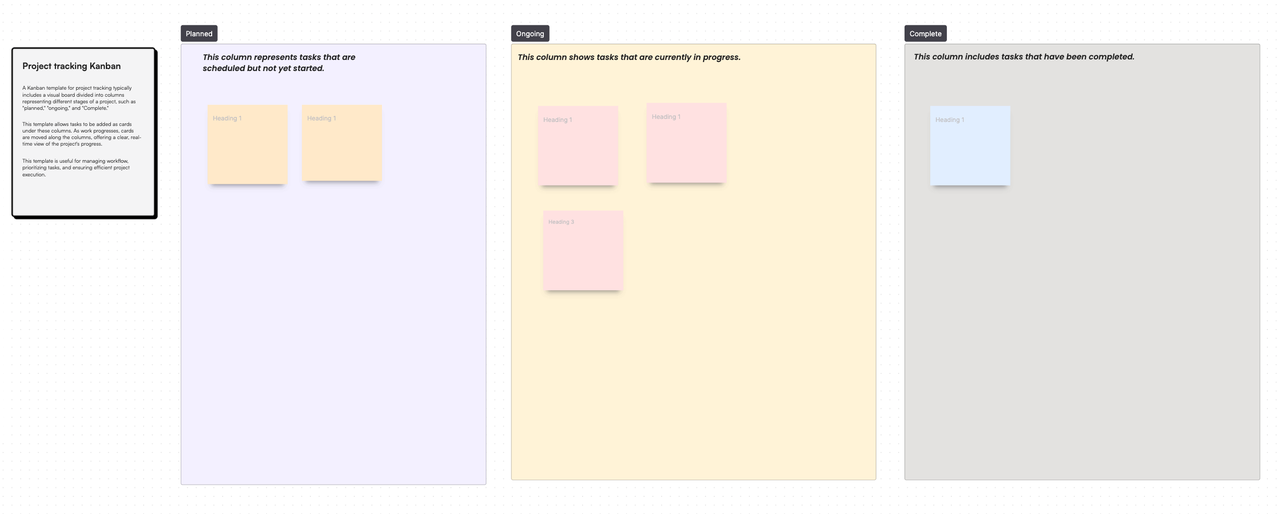 Visualize Emily, a team leader, grappling with the challenge of managing her team's diverse tasks and deadlines. She introduces a project-tracking Kanban board in the office. This project whiteboard layout is divided into columns: 'To Do', 'In Progress', 'Review', and 'Completed'. Each task, represented by a coloured sticky note, moves through these stages. The colours denote different project categories, making it easy to identify tasks at a glance. This Kanban system transforms Emily's team's workflow, providing clarity on task status and accountability, streamlining project tracking, and significantly enhancing team productivity and collaboration. * Clear Column Labels: Define each stage of the project clearly, such as 'To Do', 'In Progress', 'Review', and 'Completed'. This helps in easily tracking the status of each task. * Visual Task Representation: Use cards or sticky notes for tasks, making it simple to move them between columns. Different colours or shapes can indicate task priority or category. * Limited Work-in-Progress: Set limits for the number of tasks in certain columns, especially 'In Progress', to prevent bottlenecks and ensure smooth workflow. **Wanna get started with this layout right away,** [click here](https://app.affine.pro)**!** ### 8) [Presentation](https://affine.pro) 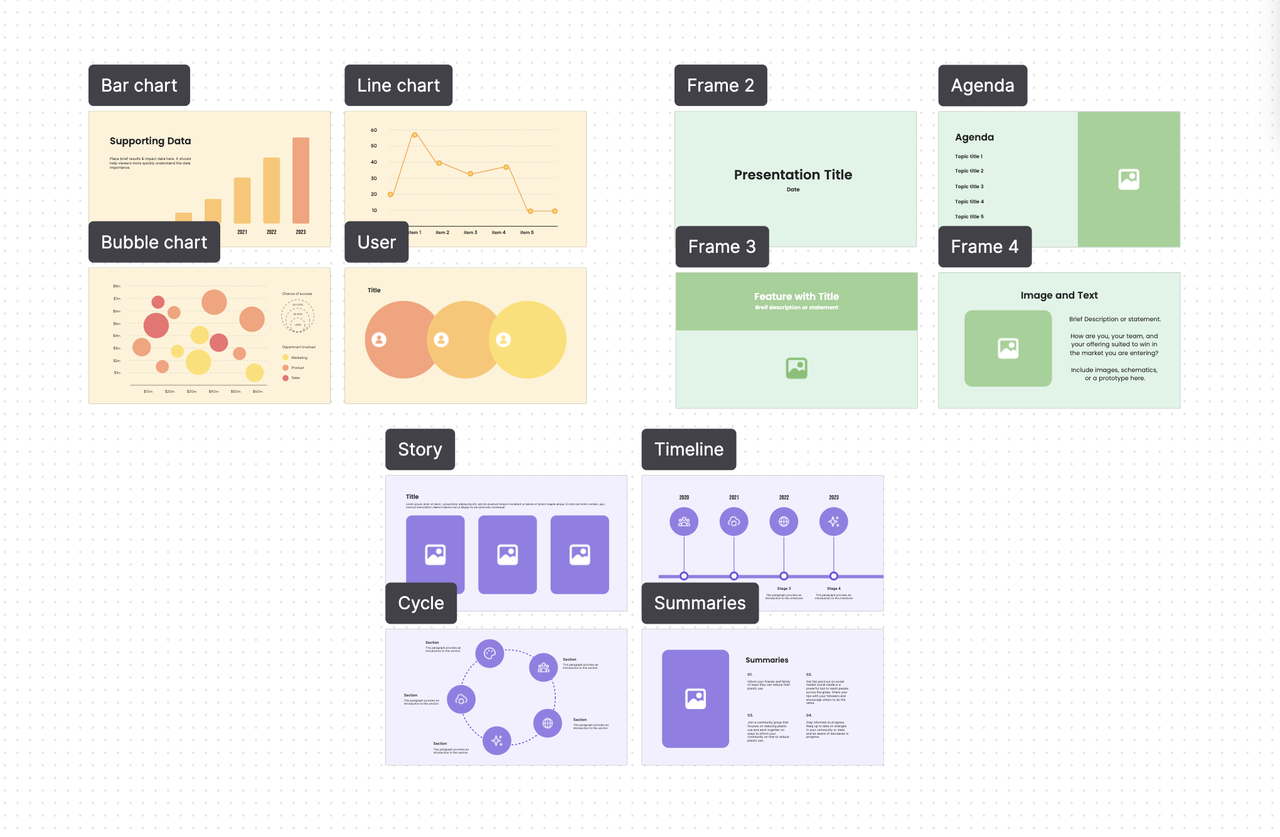 Transforming data into compelling stories is a universal need across professions. AFFiNE's Presentation template within the whiteboard is crafted for the data analyst seeking to influence decision-makers, the marketing professional aiming to pitch to clients, and the educator tasked with engaging a digital classroom. It’s equally embraced by teams in need of presenting cohesive narratives in boardrooms and by individuals looking to impress at community meetups. * Structure and Flow: Organize content logically, with a clear beginning, middle, and end. Use headings, bullet points, and visuals to guide the audience through the presentation. * Visual Enhancements: Incorporate graphics, charts, and images to illustrate key points and engage the audience. Visual elements should complement the spoken content. * Interactive Elements: Leave space for interactive elements like polls, questions, or brainstorming sessions to engage the audience actively during the presentation. These can be added and modified as needed during the presentation. **Wanna get started with this layout right away,** [click here](https://app.affine.pro)**!** ### 9) [Gantt chart](https://affine.pro) whiteboard layout idea for work 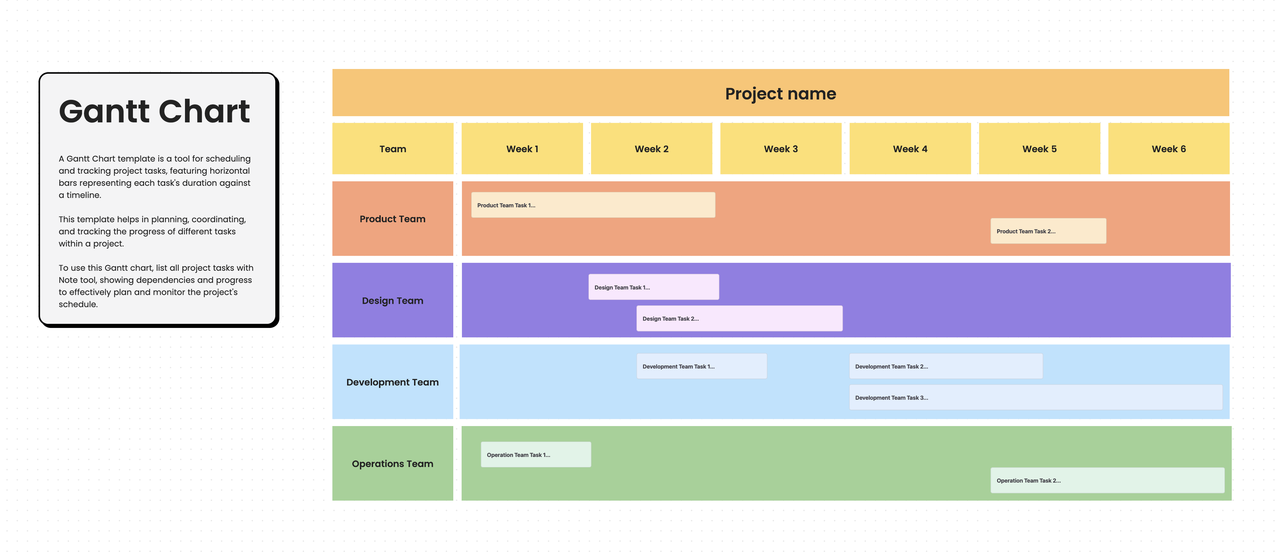 In the realm of project management, a project manager often grapples with complex challenges such as difficulties in cross-departmental communication, looming deadlines, and evolving project requirements. These challenges can lead to project delays, dampened team morale, and even compromised quality of final outcomes. In such scenarios, a well-designed whiteboard layout can be a game-changer. Picture a whiteboard divided into several key areas: a dynamic Gantt chart clearly depicting each project phase and critical tasks; a dedicated section for real-time updates and highlighting urgent matters; another area specifically for team member queries and feedback, and a flexible brainstorming zone for immediate problem-solving and innovative thinking. This layout not only enables the project manager to track progress more effectively, reducing the risks of oversights and misunderstandings but also provides a centralized platform for team communication and collaboration, greatly enhancing transparency and engagement within the entire project * Clarity in Gantt Chart: Ensure the Gantt chart is easy to read and update, with distinct colours and legible text to delineate different project phases and tasks. * Prioritization in Updates Section: The real-time updates section should clearly prioritize urgent matters, possibly with color coding or symbols to indicate the level of urgency. * Accessibility for Team Feedback: The area for team queries and feedback should be accessible and inviting, encouraging team members to contribute regularly. **Wanna get started with this layout right away,** [click here](https://app.affine.pro)**!** ### 10) [4p marketing matrix](https://affine.pro) 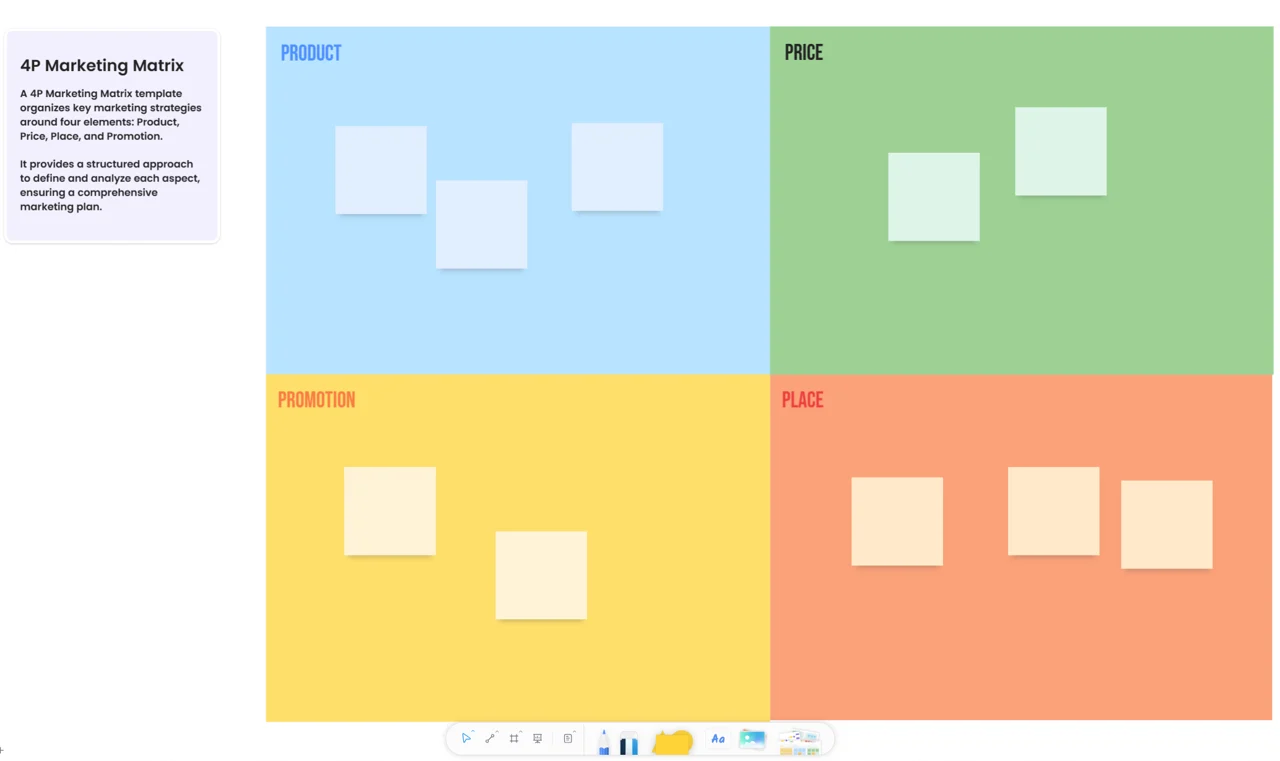 Consider a marketing professional, Alex, facing challenges in crafting a comprehensive marketing strategy. He utilizes a whiteboard divided into four sections, each representing one aspect of the 4Ps (Product, Price, Place, Promotion) marketing model. Alex outlines the attributes and benefits of the product, sets competitive pricing strategies, identifies optimal distribution channels, and brainstorms promotional tactics. This visual approach on a whiteboard, as opposed to traditional documents, offers a dynamic and interactive platform for Alex to engage with the strategy, allowing for easy modifications and collaborative input. It resolves his confusion around integrating the 4Ps, leading to a more cohesive and effective marketing plan. * Segmentation: Clearly divide the whiteboard into four sections for Product, Price, Place, and Promotion. This provides a structured framework for analysis. * Visual Clarity: Use visual aids like charts, diagrams, or icons to represent each element effectively. Visuals make it easier to grasp the marketing strategy. * Data Integration: Populate each section with relevant data and insights, ensuring that the matrix provides actionable information for marketing decision-making. **Wanna get started with this layout right away,** [click here](https://app.affine.pro)**!** ## Getting Started with Free Whiteboard layout right away with [AFFiNE](https://app.affine.pro) now! 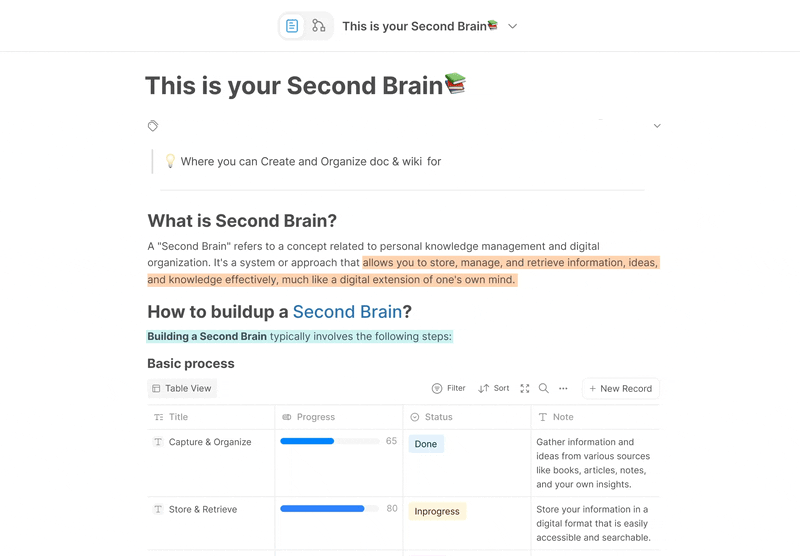 AFFiNE is a versatile editor that lets you write, draw, plan, and present all in one place. Easily capture detailed information about your new business using the page mode, allowing for straightforward document editing. Efficiently organize your projects by using a database to keep track of deadlines, assign responsibilities, and effortlessly monitor project progress. Take advantage of AFFiNE's powerful whiteboard feature to brainstorm ideas with your team. Moreover, craft visually appealing posters about your business for seamless publication and display on different social media platforms. AFFiNE offers a user-friendly platform for comprehensive business management and seamless team collaboration. |Column 1|Title| |---|---|
title: "10 Best Free Whiteboard Layout Ideas in 2025: How to be More Productive?"
author: Jackie Peng
tags: Content
slug: best-free-whiteboard-layout-ideas-organization
description: “Explore innovative ways to organize your thoughts, plan projects, and tackle complex tasks. Discover how whiteboard layout ideas/setup can streamline your workflow and make information visually engaging, whether in the office, classroom or at home.”
created: 2024-01-03
updated: 2025-01-03
layout: blog
publish: true
Imagine being a project manager leading a complex, multi-departmental project involving various stages, key milestones, and stakeholder expectations. In this scenario, effectively conveying complex concepts, coordinating team members, and planning the project's path is crucial. A well-structured whiteboard layout plays a key role here.
Using a whiteboard, you can create areas to map different project stages, list key tasks and assign responsibilities, and have a dedicated space for creative brainstorming and problem-solving. This layout not only helps you and your team stay organized and focused but also provides a visual platform for tracking progress and facilitating communication among team members. Whether it's outlining a complex project plan or planning a team-building trip, a well-thought-out whiteboard layout simplifies the process and enhances team efficiency.
So what is the Whiteboard Layout idea?

"Whiteboard Layout idea" refers to strategic methods of organizing a whiteboard to enhance productivity and efficiency in various settings, like offices, classrooms, or personal workspaces. These layouts are designed to optimize the use of space on a whiteboard for different purposes, such as project planning, brainstorming, or tracking tasks. Here’s an expansion on this concept:
- Sectioned Areas: Divide the board into specific sections for distinct purposes, like a 'To-Do' list, a 'Brainstorming' area, and a 'Project Timeline'.
- Color Coding: Use different colors to distinguish between tasks, priorities, or teams, making information visually distinguishable and easier to process.
- Visual Aids: Incorporate diagrams, flowcharts, or graphs to represent complex information or data, aiding in clearer understanding.
- Progress Trackers: Designate areas to track the progress of projects or goals, using tools like Gantt charts or Kanban boards.
- Idea Generation Space: Reserve a freeform area for creative thinking and spontaneous ideas, encouraging innovation and team collaboration. Such layouts turn a simple whiteboard into a dynamic, multifunctional tool, greatly aiding in organizing thoughts, visualizing projects, and fostering a collaborative environment.

Why do the Whiteboard layout ideas matter that much?
Organize whiteboard layout matters significantly because:
- A good whiteboard setup idea enhances Organization: A well-structured layout helps in organizing thoughts, tasks, and projects in a coherent manner, making it easier to track and manage.
- Boosts Productivity: By clearly visualizing tasks and deadlines, a whiteboard layout can streamline workflow, reduce time spent on planning, and increase overall productivity.
- Facilitates Collaboration: In team settings, a well-planned whiteboard layout promotes effective communication, ensuring that all team members are on the same page and can contribute ideas easily.
- Adapts to Different Needs: Different layouts can cater to various needs, whether it's for brainstorming, project management, or goal tracking, making it a versatile tool in both professional and personal settings.
- Encourages Creativity: A designated space for brainstorming or freeform ideas can stimulate creative thinking and innovation.
10 Best Whiteboard layout ideas for work, home and daily life in AFFiNE
1) Project planning whiteboard layout idea

Imagine Jake, a project planner tasked with organizing a large-scale corporate event. His primary challenges include coordinating with numerous participants, setting clear objectives, understanding user needs, ensuring tangible benefits for users, planning various activities, and overseeing the creation of deliverables. The complexity and scale of the event mean Jake must be meticulous in his planning to avoid overlooking key details and to ensure every aspect aligns with the overall goal.
To tackle this, Jake creates a project layout board. Each section - 'Participants', 'Goals', 'Users', 'User Benefits', 'Activities', and 'Deliverables' - is carefully laid out on a whiteboard. This visual tool helps him map out every component of the event. It becomes instrumental in tracking responsibilities, aligning team efforts with user expectations, and ensuring that every deliverable is accounted for and aligns with the set goals. This approach not only streamlines the planning process but also significantly reduces the risk of errors and miscommunication, ensuring a successful and well-organized event.
Note that:
- Clear Task Organization: Ensure that tasks are organized logically, possibly in a chronological order or based on project phases, so that team members can easily understand the project's structure and progression.
- Dependencies and Relationships: Use arrows or lines to indicate task dependencies and relationships. This visual representation helps in understanding which tasks are linked and how they impact each other.
- Key Milestones and Deadlines: Highlight critical milestones and deadlines prominently on the whiteboard. This ensures that all team members are aware of important dates and can plan their work accordingly. Wanna get started with this layout right away, click here!
2) Storyboard Template

Consider a product designer at a tech company tasked with developing a new mobile app. This project requires a deep understanding of user experience, functionality, and design aesthetics. Storyboarding becomes a critical tool to visualize the user journey.
Imagine the storyboard divided into panels representing different app screens, each illustrating user interactions, transitions, and key features. Additional sections outline user scenarios, potential challenges, and solutions. This detailed storyboard layout not only aids in visualizing the app's flow but also fosters collaboration with developers and stakeholders, ensuring a user-centric design that effectively meets the needs and expectations of the target audience.
Note that:
- Clarity: Ensure each element is clear enough for all viewers to easily understand.
- Coloir Usage: Use colours judiciously to differentiate elements or highlight key points. Colors can signify emotions, priorities, or categories.
- Visual Flow: The layout should guide the viewer's eye smoothly from one element to the next, creating a logical narrative sequence.
- Space Utilization: Arrange each section thoughtfully to avoid overcrowding, leaving ample space for expansion or annotations.
- Consistency: Maintain consistency in icons, fonts, and styles throughout the storyboard for easy recognition and comprehension. Wanna get started with this layout right away, click here!
3) Swot map whiteboard layout idea

Imagine Laura, preparing for job interviews but uncertain about her strengths, weaknesses, opportunities, and threats (SWOT). She creates a SWOT analysis whiteboard to gain clarity.
On the board, four quadrants represent each SWOT element. She lists her skills and experiences as strengths, identifies areas for improvement as weaknesses, notes potential career opportunities, and acknowledges external factors as threats. This visual SWOT analysis on her whiteboard helps Laura understand her professional profile, preparing her effectively for interviews by highlighting her assets and areas for growth, ultimately boosting her confidence and readiness for her job search journey.
- Clear Quadrant Separation: Ensure that the whiteboard is divided into four distinct quadrants for Strengths, Weaknesses, Opportunities, and Threats. Clear separation allows for a focused analysis of each category.
- Visual Representation: Use visual cues such as icons or color coding to make each point stand out within its respective quadrant. This aids in quickly identifying and understanding each SWOT element.
- Actionable Insights: Encourage the team to discuss potential actions or strategies based on the SWOT analysis. Leave space for notes or ideas on how to leverage strengths, address weaknesses, seize opportunities, and mitigate threats. This makes the analysis actionable and practical. Wanna get started with this layout right away, click here!
4) Smart Goal Template

Imagine Brian, a strategic executive, grappling with setting clear and actionable goals for his company's next big project. To bring structure to this process, he turns to a whiteboard organized by the SMART (Specific, Measurable, Achievable, Relevant, Time-bound) criteria.
Brian's whiteboard is divided into sections, each dedicated to one of the SMART principles. In 'Specific', he defines the project's exact goals. 'Measurable' is used to establish criteria for tracking progress. 'Achievable' outlines the steps needed to reach these goals, ensuring they are realistic. 'Relevant' ensures the goals align with the company's broader objectives, and 'Time-bound' sets clear deadlines. This SMART board becomes a roadmap, guiding Brian's team to set and achieve well-defined, strategic objectives, ensuring the project's success and alignment with the company's overall vision.
- Clear Goal Definition: Dedicate a section to define specific and concise goals, ensuring everyone understands what needs to be achieved.
- Measurable Criteria: Include criteria and metrics for measuring progress and success. This allows for objective evaluation.
- Timeline and Accountability: Set clear deadlines and assign responsibilities. This helps in keeping the project on track and ensures accountability among team members. Once Brian’s team hits key milestones outlined in the SMART template, like nailing a measurable target or meeting a time-bound deadline, celebrate their progress with Custom Medals. Engraved with the goal name, achievement date, or team logo, these medals turn the whiteboard’s strategic plans into tangible triumphs.

They boost morale, honor accountability, and serve as lasting reminders of how structured goals fuel real success. Order now and get the medals as fast as possible.
Wanna get started with this layout right away, click here!
5) Calendar for daily/monthly whiteboard ideas

Anna, a dedicated working mother, faces the daily challenge of balancing a demanding job with her children's school activities and household responsibilities. Her routine includes a myriad of tasks ranging from professional meetings and deadlines to soccer practices, ballet recitals, and ensuring the home runs smoothly.
To bring order to this chaos, Anna turns to a large whiteboard in her kitchen, transformed into a comprehensive digital monthly calendar. It's a kaleidoscope of colour-coded sections: yellow for work commitments, pink for each child's school and extracurricular activities, and green for family events and medical appointments. The lower section of the board is dedicated to meal planning and grocery lists, simplifying her weekly shopping chores. This whiteboard, more than just a planning tool, becomes the focal point of Anna's family life. It not only helps her keep track of diverse schedules but also ensures that she maintains a delicate balance between her professional responsibilities and her role as a mother, alleviating the stress of managing a busy household.
Note that:
- Clarity and Legibility: Ensure that the calendar is clear and easy to read from a distance. Use large, legible fonts and distinct colors for different types of events or tasks.
- Flexibility for Changes: Incorporate elements like sticky notes or erasable markers, allowing for easy updates or adjustments as plans evolve throughout the month.
- Space Allocation: Allocate sufficient space for each day, providing ample room for detailed notes or multiple entries, ensuring that the calendar doesn't become cluttered and remains organized. Wanna get started with this layout right away, click here!
6) Concept Map

Imagine Mr. Thompson, a high school biology teacher, struggling to convey complex theories and concepts to his diverse group of students. To enhance understanding and engagement, he turns to a concept map.
In his classroom, a digital whiteboard is transformed into this map. It's a web of interconnected ideas: central theories in the middle, branching out to sub-concepts and examples. Each branch is colour-coded by topic, with real-world examples and diagrams to illustrate abstract ideas. This visual and interactive approach transforms Mr. Thompson's teaching, making complex theories accessible and engaging. Students can see how different concepts connect, fostering a deeper understanding and making learning more dynamic and enjoyable.
- Logical Flow and Organization: Arrange concepts in a way that clearly shows the relationships and hierarchy between them. This helps in understanding the overall structure and how individual ideas connect.
- Use of Color and Symbols: Utilize different colors and symbols to distinguish between various concepts and links. This visual differentiation aids in quick recognition and understanding of the map.
- Space for Expansion: Leave ample space around each concept to add details or additional sub-concepts. A concept map often evolves, so flexibility for growth is essential. Wanna get started with this layout right away, click here!
7) Project-tracking Kanban

Visualize Emily, a team leader, grappling with the challenge of managing her team's diverse tasks and deadlines. She introduces a project-tracking Kanban board in the office.
This project whiteboard layout is divided into columns: 'To Do', 'In Progress', 'Review', and 'Completed'. Each task, represented by a coloured sticky note, moves through these stages. The colours denote different project categories, making it easy to identify tasks at a glance. This Kanban system transforms Emily's team's workflow, providing clarity on task status and accountability, streamlining project tracking, and significantly enhancing team productivity and collaboration.
- Clear Column Labels: Define each stage of the project clearly, such as 'To Do', 'In Progress', 'Review', and 'Completed'. This helps in easily tracking the status of each task.
- Visual Task Representation: Use cards or sticky notes for tasks, making it simple to move them between columns. Different colours or shapes can indicate task priority or category.
- Limited Work-in-Progress: Set limits for the number of tasks in certain columns, especially 'In Progress', to prevent bottlenecks and ensure smooth workflow. Wanna get started with this layout right away, click here!
8) Presentation

Transforming data into compelling stories is a universal need across professions. AFFiNE's Presentation template within the whiteboard is crafted for the data analyst seeking to influence decision-makers, the marketing professional aiming to pitch to clients, and the educator tasked with engaging a digital classroom. It’s equally embraced by teams in need of presenting cohesive narratives in boardrooms and by individuals looking to impress at community meetups.
- Structure and Flow: Organize content logically, with a clear beginning, middle, and end. Use headings, bullet points, and visuals to guide the audience through the presentation.
- Visual Enhancements: Incorporate graphics, charts, and images to illustrate key points and engage the audience. Visual elements should complement the spoken content.
- Interactive Elements: Leave space for interactive elements like polls, questions, or brainstorming sessions to engage the audience actively during the presentation. These can be added and modified as needed during the presentation. Wanna get started with this layout right away, click here!
9) Gantt chart whiteboard layout idea for work

In the realm of project management, a project manager often grapples with complex challenges such as difficulties in cross-departmental communication, looming deadlines, and evolving project requirements. These challenges can lead to project delays, dampened team morale, and even compromised quality of final outcomes. In such scenarios, a well-designed whiteboard layout can be a game-changer.
Picture a whiteboard divided into several key areas: a dynamic Gantt chart clearly depicting each project phase and critical tasks; a dedicated section for real-time updates and highlighting urgent matters; another area specifically for team member queries and feedback, and a flexible brainstorming zone for immediate problem-solving and innovative thinking. This layout not only enables the project manager to track progress more effectively, reducing the risks of oversights and misunderstandings but also provides a centralized platform for team communication and collaboration, greatly enhancing transparency and engagement within the entire project
- Clarity in Gantt Chart: Ensure the Gantt chart is easy to read and update, with distinct colours and legible text to delineate different project phases and tasks.
- Prioritization in Updates Section: The real-time updates section should clearly prioritize urgent matters, possibly with color coding or symbols to indicate the level of urgency.
- Accessibility for Team Feedback: The area for team queries and feedback should be accessible and inviting, encouraging team members to contribute regularly. Wanna get started with this layout right away, click here!
10) 4p marketing matrix

Consider a marketing professional, Alex, facing challenges in crafting a comprehensive marketing strategy. He utilizes a whiteboard divided into four sections, each representing one aspect of the 4Ps (Product, Price, Place, Promotion) marketing model.
Alex outlines the attributes and benefits of the product, sets competitive pricing strategies, identifies optimal distribution channels, and brainstorms promotional tactics. This visual approach on a whiteboard, as opposed to traditional documents, offers a dynamic and interactive platform for Alex to engage with the strategy, allowing for easy modifications and collaborative input. It resolves his confusion around integrating the 4Ps, leading to a more cohesive and effective marketing plan.
- Segmentation: Clearly divide the whiteboard into four sections for Product, Price, Place, and Promotion. This provides a structured framework for analysis.
- Visual Clarity: Use visual aids like charts, diagrams, or icons to represent each element effectively. Visuals make it easier to grasp the marketing strategy.
- Data Integration: Populate each section with relevant data and insights, ensuring that the matrix provides actionable information for marketing decision-making. Wanna get started with this layout right away, click here!
Getting Started with Free Whiteboard layout right away with AFFiNE now!

AFFiNE is a versatile editor that lets you write, draw, plan, and present all in one place. Easily capture detailed information about your new business using the page mode, allowing for straightforward document editing. Efficiently organize your projects by using a database to keep track of deadlines, assign responsibilities, and effortlessly monitor project progress. Take advantage of AFFiNE's powerful whiteboard feature to brainstorm ideas with your team. Moreover, craft visually appealing posters about your business for seamless publication and display on different social media platforms. AFFiNE offers a user-friendly platform for comprehensive business management and seamless team collaboration.
| Column 1 | Title |
|---|